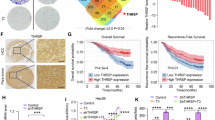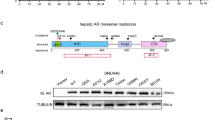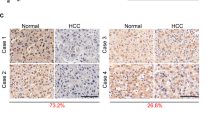Abstract
Aberrant thyroid hormone receptors (TRs) are found in over 70% of the human hepatocellular carcinomas (HCCs) analysed. To better understand the role(s) of these TR mutants in this neoplasia, we analysed a panel of HCC mutant receptors for their molecular properties. Virtually all HCC-associated TR mutants tested retained the ability to repress target genes in the absence of T3, yet were impaired in T3-driven gene activation and functioned as dominant-negative inhibitors of wild-type TR activity. Intriguingly, the HCC TRα1 mutants exerted dominant-negative interference at all T3 concentrations tested, whereas the HCC TRβ1 mutants were dominant-negatives only at low and intermediate T3 concentrations, reverting to transcriptional activators at higher hormone levels. The relative affinity for the SMRT versus N-CoR corepressors was detectably altered for several of the HCC mutant TRs, suggesting changes in corepressor preference and recruitment compared to wild type. Several of the TRα HCC mutations also altered the DNA recognition properties of the encoded receptors, indicating that these HCC TR mutants may regulate a distinct set of target genes from those regulated by wild-type TRs. Finally, whereas wild-type TRs interfere with c-Jun/AP-1 function in a T3-dependent fashion and suppress anchorage-independent growth when ectopically expressed in HepG2 cells, at least certain of the HCC mutants did not exert these inhibitory properties. These alterations in transcriptional regulation and DNA recognition appear likely to contribute to oncogenesis by reprogramming the differentiation and proliferative properties of the hepatocytes in which the mutant TRs are expressed.
This is a preview of subscription content, access via your institution
Access options
Subscribe to this journal
Receive 50 print issues and online access
$259.00 per year
only $5.18 per issue
Buy this article
- Purchase on SpringerLink
- Instant access to full article PDF
Prices may be subject to local taxes which are calculated during checkout








Similar content being viewed by others
References
Ando S, Sarlis NJ, Oldfield EH, Yen PM . (2001). J Clin Endocrinol Metab 86: 5572–5576.
Apriletti JW, Ribeiro RC, Wagner RL, Feng W, Webb P, Kushner PJ et al. (1998). Clin Exp Pharmacol Physiol Suppl 25: S2–S11.
Barlow C, Meister B, Lardelli M, Lendahl U, Vennstrom B . (1994). EMBO J 13: 4241–4250.
Beato M, Klug J . (2000). Hum Reprod Update 6: 225–236.
Chaterjee VKK . (1997). Hormone Res 48: 43–46.
Chen H, Smit-McBride Z, Lewis S, Sharif M, Privalsky ML . (1993). Mol Cell Biol 13: 2366–2376.
Cheng SY . (2003). Mol Cell Endocrinol 213: 23–30.
DeGroot LJ . (1996). Ann Intern Med 125: 623.
Desbois C, Aubert D, Legrand C, Pain B, Samarut J . (1991). Cell 67: 731–740.
Eferl R, Wagner EF . (2003). Nat Rev Cancer 3: 859–868.
Farboud B, Privalsky ML . (2004). Mol Endocrinol 18: 2839–2853.
Furumoto H, Ying H, Chandramouli GV, Zhao L, Walker RL, Meltzer PS et al. (2005). Mol Cell Biol 25: 124–135.
Garcia-Silva S, Aranda A . (2004). Mol Cell Biol 24: 7514–7523.
Glass CK . (1996). J Endocrinol 150: 349–357.
Glass CK, Rosenfeld MG . (2000). Genes Dev 14: 121–141.
Gonzalez-Sancho JM, Garcia V, Bonilla F, Munoz A . (2003). Cancer Lett 192: 121–132.
Goodson ML, Jonas BA, Privalsky ML . (2005). J Biol Chem 280: 7493–7503.
Guan KL, Dixon JE . (1991). Analyt Biochem 192: 262–267.
Horwitz KB, Jackson TA, Bain DL, Richer JK, Takimoto GS, Tung L . (1996). Mol Endocrinol 10: 1167–1177.
Huber-Gieseke T, Pernin A, Huber O, Burger AG, Meier CA . (1997). Oncology 54: 214–219.
Ikeda M, Wilcox EC, Chin WW . (1996). J Biol Chem 271: 23096–23104.
Jonas BA, Privalsky ML . (2004). J Biol Chem 279: 54676–54686.
Judelson C, Privalsky ML . (1996). J Biol Chem 271: 10800–10805.
Kamiya Y, Puzianowska-Kuznicka M, McPhie P, Nauman J, Cheng SY, Nauman A . (2002). Carcinogenesis 23: 25–33.
Kamiya Y, Zhang XY, Ying H, Kato Y, Willingham MC, Xu J et al. (2003). Endocrinology 144: 4144–4153.
Kato Y, Ying H, Willingham MC, Cheng SY . (2004). Endocrinology 145: 4430–4438.
Koenig RJ . (1998). Thyroid 8: 703–713.
Kopp P, Kitajima K, Jameson JL . (1996). Proc Soc Exp Biol Med 211: 49–61.
Lazar MA . (1993). Endocrine Rev 14: 184–193.
Lee JW, Chen JY, Yang CS, Doong SL . (2002). Cancer Lett 184: 149–156.
Lee MO, Kang HJ . (2002). Biol Pharm Bull 25: 1298–1302.
Lee S, Privalsky ML . (2005). Mol Endocrinol 19: 863–878.
Leng X, Tsai SY, O'Malley BW, Tsai MJ . (1993). J Steroid Biochem Mol Biol 46: 643–661.
Lin BC, Hong SH, Krig S, Yoh SM, Privalsky ML . (1997a). Mol Cell Biol 17: 6131–6138.
Lin KH, Shieh HY, Chen SL, Hsu HC . (1999). Mol Carcinog 26: 53–61.
Lin KH, Wu YH, Chen SL . (2001). Endocrinology 142: 653–662.
Lin KH, Zhu XG, Hsu HC, Chen SL, Shieh HY, Chen ST et al. (1997b). Endocrinology 138: 5308–5315.
Liu Y, Takeshita A, Misiti S, Chin WW, Yen PM . (1998). Endocrinology 139: 4197–4204.
Luisi BF, Xu WX, Otwinowski Z, Freedman LP, Yamamoto KR, Sigler PB . (1991). Nature 352: 497–505.
Mangelsdorf DJ, Thummel C, Beato M, Herrlich P, Schütz G, Umesono K et al. (1995). Cell 83: 835–839.
Matsushita A, Misawa H, Andoh S, Natsume H, Nishiyama K, Sasaki S et al. (2000). J Endocrinol 167: 493–503.
Moehren U, Eckey M, Baniahmad A . (2004). Essays Biochem 40: 89–104.
Murata Y . (1998). Nagoya J Med Sci 61: 103–115.
Nagaya T, Fujieda M, Seo H . (1998). Biochem Biophys Res Commun 247: 620–623.
Nagaya T, Seo H . (1998). Endocr J 45: 709–718.
Ordentlich R, Downes M, Evans RM . (2001). Curr Topics Microbiol Immunol 254: 101–116.
Pfahl M . (1993). Endocr Rev 14: 651–658.
Privalsky ML . (2004). Annu Rev Physiol 66: 315–360.
Puzianowska-Kuznicka M, Krystyniak A, Madej A, Cheng SY, Nauman J . (2002). J Clin Endocrinol Metab 87: 1120–1128.
Rastinejad F, Perlmann T, Evans RM, Sigler PB . (1995). Nature 375: 203–211.
Refetoff S . (1993). Clin Lab Med 13: 563–581.
Ribeiro RC, Apriletti JW, Wagner RL, West BL, Feng W, Huber R et al. (1998). Recent Prog Horm Res 53: 351–392 discussion 392–354.
Safer JD, Cohen RN, Hollenberg AN, Wondisford FE . (1998). J Biol Chem 273: 30175–30182.
Sande S, Sharif M, Chen H, Privalsky M . (1993). J Virol 67: 1067–1074.
Schmidt ED, Cramer SJ, Offringa R . (1993). Biochem Biophys Res Commun 192: 151–160.
Sharif M, Privalsky ML . (1992). Oncogene 7: 953–960.
Sisley K, Curtis D, Rennie IG, Rees RC . (1993). Melanoma Res 3: 457–461.
Starr DB, Matsui W, Thomas JR, Yamamoto KR . (1996). Genes Dev 10: 1271–1283.
Suriawinata A, Xu R . (2004). Semin Liver Dis 24: 77–88.
Tagami T, Jameson JL . (1998). Endocrinology 139: 640–650.
Tenbaum S, Baniahmad A . (1997). Int J Biochem Cell Biol 29: 1325–1341.
Wagner RL, Apriletti JW, McGrath ME, West BL, Baxter JD, Fletterick RJ . (1995). Nature 378: 690–697.
Wang CS, Lin KH, Hsu YC . (2002). Cancer Lett 175: 121–127.
Weinberger C, Thompson CC, Ong ES, Lebo R, Gruol DJ, Evans RM . (1986). Nature 324: 641–646.
Winter WE, Signorino MR . (2001). Ann Clin Lab Sci 31: 221–244.
Wong CW, Privalsky ML . (1998). Mol Cell Biol 18: 5724–5733.
Yen PM, Cheng SY . (2003). J Endocrinol Invest 26: 780–787.
Yoh SM, Chatterjee VK, Privalsky ML . (1997). Mol Endocrinol 11: 470–480.
Yoh SM, Privalsky ML . (2000). Mol Cell Endocrinol 159: 109–124.
Zamir I, Zhang J, Lazar MA . (1997). Genes Dev 11: 835–846.
Zhang J, Lazar MA . (2000). Annu Rev Physiol 62: 439–466.
Zhang XK, Wills KN, Husmann M, Hermann T, Pfahl M . (1991). Mol Cell Biol 11: 6016–6025.
Acknowledgements
We thank Liming Liu for superb technical assistance. This work was supported by Public Health Service/National Institutes of Health award R37-CA53394.
Author information
Authors and Affiliations
Corresponding author
Rights and permissions
About this article
Cite this article
Chan, I., Privalsky, M. Thyroid hormone receptors mutated in liver cancer function as distorted antimorphs. Oncogene 25, 3576–3588 (2006). https://doi.org/10.1038/sj.onc.1209389
Received:
Revised:
Accepted:
Published:
Issue date:
DOI: https://doi.org/10.1038/sj.onc.1209389
Keywords
This article is cited by
-
Direct effects of thyroid hormones on hepatic lipid metabolism
Nature Reviews Endocrinology (2018)
-
Thyroid hormone actions in liver cancer
Cellular and Molecular Life Sciences (2013)
-
Thyroid hormone receptors promote metastasis of human hepatoma cells via regulation of TRAIL
Cell Death & Differentiation (2012)
-
Genetic features of thyroid hormone receptors
Journal of Genetics (2012)
-
Thyroid hormone receptor β1 domains responsible for the antagonism with the ras oncogene: role of corepressors
Oncogene (2011)



